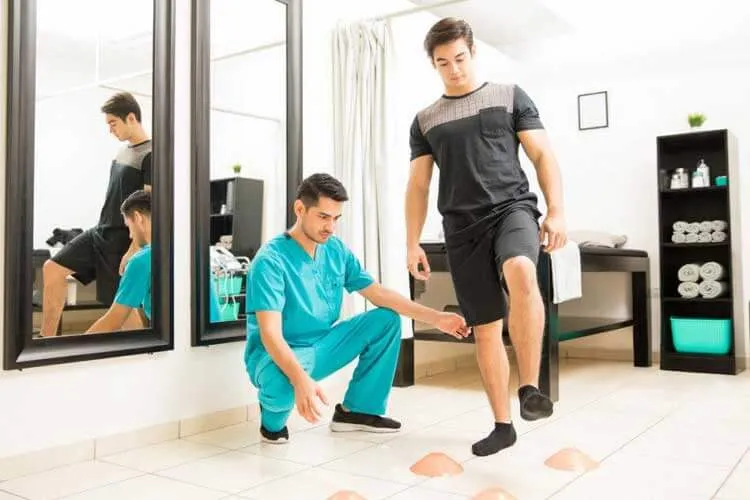Physical therapists are the caregivers that help people overcome their medical disorders, illnesses and injuries. They work with patients of any age to ensure optimal function through physical rehabilitation.
The physical therapist’s goal is to get people back on their feet, functioning at 100%. This includes encouraging them engage in activities and routine modifications that could prevent additional injury or help improve general well being.
At the first sign of a problem, primary care doctors usually refer patients to physical therapy, a conservative approach to monitoring conditions.
Don’t know why physical therapy or physical treatment is so important? Check why:
Physical therapy benefits

1. Physical therapists reduce or eliminate the pain
Physical therapy is an excellent way to alleviate pain and restore function and improve mobility. For example, soft tissue or joint mobilization can be used in the treatment process as well because these treatments often result with relief from pelvic congestion syndrome-related symptoms like severe backache that may occur during pregnancy!
2. Avoid surgery if at all possible
Physical therapy is often an option for people who have had surgery to treat their injuries, because it can help reduce pain and encourage healing.
Even if you need surgery, physical therapy can still help. You’ll heal more quickly after surgery in many circumstances if you go in stronger and fit. Health care costs are also lowered as a result of avoiding surgery.
Physical therapists understand and work with patients to alleviate their discomfort and increase their walking ability. Some chronic pain and mobility issues may necessitate surgery.
Many chronic diseases and ailments benefit from physical therapy in terms of symptom reduction. It can also prevent the worsening of a wide range of issues. It is possible to avoid surgery and the associated costs and risks by working with a physical therapist.
Some disorders, such as musculoskeletal injuries, meniscal tears, and osteoarthritis of the knee, can be treated with physical therapy as with surgery and degenerative disc disease.
Try physical rehabilitation before undergoing surgery.
Surgery is an unavoidable necessity in some instances. Surgery recovery and preparation are aided by physical therapy.
3. Physical therapy helps with Mobility
Physical therapy helps manage age-related issues by improving mobility and physical function using prevention exercise programs that eliminate pain. One’s capacity to move more freely can be restored by strengthening and stretching and avoiding further injury.
Assistive devices such as crutches, canes, and orthotics can all be adequately fitted by physical therapists.
Any vital activity in an individual’s life can be practiced and tailored for maximum safety by creating an individual care plan.
4. Stroke Rehabilitation
After a stroke, it’s normal to experience some loss of function and movement. Therapeutic exercises using strengthening exercises and regaining proper gait and equilibrium can help stroke patients’ ability.
Physical therapy techniques can improve stroke patients’ mobility in bed and their ability to take care of themselves at home. They are less dependent on others for daily tasks like getting dressed, taking a bath, or using the restroom and their overall health.
5. Preventing and Recovering from Sports Injuries
Playing sports can exacerbate a sports injury, and physical therapists are well-versed in this (for example, stress fractures for distance runners). So that you may safely return to your sport, they can provide specialized treatment or choose physical therapy for your recovery and prevention. Such therapies are called sports physical therapy.
6. Reduce the Risk of Injuries to Your Body
You’ll be checked for fall risk as soon as you begin physical therapy. It is common for physical therapists to give patients exercises that mimic real-life circumstances to help them improve their balance.
You’ll be given exercises to improve coordination and assistance equipment to help you walk more safely with your therapists.
With their expertise in vestibular dysfunction, physical therapists are able to pinpoint the source of your dizziness or vertigo and quickly restore proper functioning.
7. Control Diabetes and Other Vascular Diseases
Exercise can help lower blood sugar as part of a diabetes management regimen. Diabetes can also impair the feeling in the feet and legs of those who suffer from it. It is essential to teach these patients about correct foot care so that they don’t end up with more issues in the future.
8. Taking Charge of Aging Problems
A joint replacement may be necessary as people get older because of arthritis or osteoporosis. Physical therapists can help patients recover from joint replacement surgery and treat osteoarthritis or osteoporosis using traditional methods.
9. Control Cardiovascular and Pulmonary Disease
Patients who have had a heart attack or another heart-related event may have cardiac treatment, but you may benefit from physical therapy if your daily functioning has been compromised.
Using strengthening, conditioning, and breathing exercises, physical therapy can help individuals with pulmonary problems improve their quality of life while clearing fluid from their lungs.
10. Take Charge of Women’s Well-being
Women’s health is a priority for physical therapists. They can provide customized treatment to help with issues like stool incontinence, breast cancer symptoms, bowel incontinence, post partum care or urine leakage from childbirth; they also specialize in providing special care when it comes time for preventative measures against constipation/fibromyalgia pain as well as female Pelvic Floor Dysfunction (PFD), male pelvis wellness initiatives and lymphedema management so you feel your best during this important stage of life!
11. Avoid Opioids and Manage Pain
As a general rule, doctor-prescribed opioids do not alleviate pain. Physical therapists can help alleviate pain without putting patients at risk for opiate addiction.
Depressive disorders, drug abuse disorders, overdoses, and signs of opioid withdrawal are all possible side effects.
The CDC recommends physical therapy for long-term pain management since it is a safe alternative.
12. Attention to your needs and situations
Physical therapists and physical therapy assistants (PTAs) serve people of various ages and capacities. They collaborate with you to devise strategies and help you reach your objectives. A physical therapist develops a treatment plan tailored to each patient’s unique circumstances and goals.
Finding a Physical therapist

Shot of a friendly physiotherapist treating his mature patient in a rehabilitation center
A physical therapist evaluation does not require a doctor’s referral. Physical therapists’ hands-on care, education, and prescribed exercise improve patients’ quality of life.
A physical therapist’s specialty, location, and insurance acceptance can all play a role in finding the right one for you, and reaping the benefits of physical therapy.
Insurance companies commonly list physical therapy clinics that participate in plans on specific health concerns. Other medical professionals may be able to provide you with a list of local therapists they trust.

